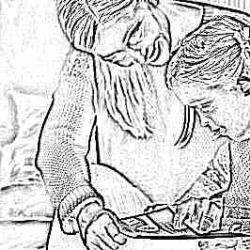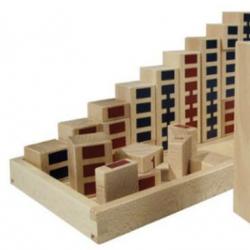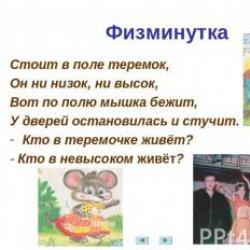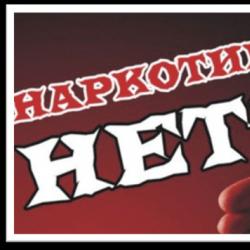Crafts of fairy-tale characters with their own hands. Characters of fairy tales from plasticine Fairy tale characters from plasticine step by step
Evgenia Davydova
Summary of GCD on modeling "My favorite fairy-tale hero"
Abstract GCD in the educational field (modeling) in the preparatory group "Cornflower".
Subject: "My favorite fairy tale character» .
Tasks:
Educational area "Artistic and aesthetic development" (modeling) :
Develop children's creativity; learn to freely use to create images of objects, objects of nature, fabulous characters a variety of techniques learned earlier; continue to teach to convey the shape of the main part and other parts, their proportions, posture, characteristic features of the depicted objects; process the surface of the form with finger movements and a stack.
Continue to form the ability to convey the characteristic movements of humans and animals, create expressive images (the bird raised its wings, prepared to fly; the goat jumps, the girl dances; children do gymnastics - a collective composition).
To teach children to create sculptural groups of two or three figures, to develop a sense of composition, the ability to convey the proportions of objects, their ratio in size, the expressiveness of postures, movements, and details.
Educational area "Speech development"
Continue to teach children dialogic speech (when considering favorite characters)
Educational area "Social and communicative development"
The formation of independence, purposefulness and self-regulation of one's own actions;
Development of emotional responsiveness, empathy, formation of readiness for joint activities with peers.
preliminary work: reading fairy tales, viewing illustrations for fairy tales, conversation on fairy tales.
Material: Clay or plasticine, stacks, coasters, oilcloths, napkins.
vocabulary work:
Methodological techniques: Artistic word, conversation, partial display, introspection of their work.
Organizational part: Children stand in a circle and greet each other.
The bell is singing
He calls all the children to the circle.
We will all come in a circle
And let's start to say hello.
caregiver (offers to solve riddles about fairy tale characters)
bewitched by a koshchei,
I am fascinated by Ivan.
green girlfriend
Princess (frog).
He hero we all know
And with the magic word together
Maybe a whole week
Lie on the stove... (Emelya).
In the summer wanders without a road
Between pines and birches
And in winter he sleeps in a lair,
Hides the nose from the cold. (bear)
caregiver: Guys, who is this riddle about? (children's answers)
caregiver: I suggest you blind characters from your favorite fairy tale. But first, let's remember what we have heroes of fairy tales(head, body, paws, legs).
caregiver: Where is the head, torso, paws, legs? (the head is above the body, the paws are at the top on the sides of the body and the legs are at the bottom on the sides).
caregiver: What is on the head? (ears above, eyes, nose and mouth in front of the head).
caregiver: Guys, now let's sit down at the table and remember who we should blind and what we need for modeling?
caregiver: Today we will sculpt from plasticine (clay). And who will we sculpt?
caregiver: How will we sculpt them? (in parts, sculptural, combined).
caregiver: How many pieces will we divide plasticine or (clay? (for 3 not equal piece: big, small and very small).
caregiver: What do we blind from a large, smaller and very small piece? Show in the air how to blind the body? (in a circular motion between the palms we roll up the ball, then with longitudinal movements we roll it out a little, we get a column - this is the torso).
caregiver: And from a smaller piece? (head).
caregiver: By what method? (roll the ball between the palms in a circular motion, pull the ears with two fingers, thumb and forefinger).
caregiver: And from a small piece? (paws and legs).
Fizminutka (about a hamster)
Hamster - hamster - hamster,
Striped barrel.
Hamster gets up early
washes cheeks,
Rubs the neck.
Homka sweeps the hut
And goes to charge.
One two three four five!
Homka wants to become strong.
And now we have discussed everything. Get to work (individual work with children)
Conclusion: Guys, whom did we sculpt today? What did they sculpt from? What techniques were used in modeling? What work did you enjoy the most and why? And who will tell about his work? Who loves their job? Why?
As a result, the GCD invites the children to make a composition from their works, consider the molded figures and guess from which fairy tale hero, encourage children and invite them to play with molded toys.
Related publications:
Quiz game "Favorite fairy tale characters" municipal budgetary preschool educational institution kindergarten No. 118. Rostov-on-Don
GCD abstract for drawing "My favorite rain" Drawing in an unconventional way "My favorite rain" Educator: Kasyanova E.V. MDOU "Kindergarten" "Scarlet Flower". I junior group.
Synopsis of the GCD "Enchanted fairy-tale hero" Synopsis of the GCD "The Enchanted Fairytale Hero" Educator Koneva Natalya Vladimirovna. MBDOU d / s No. 52 in Belgorod Purpose: development of creative.
Synopsis of GCD on getting to know the outside world "My favorite kindergarten" Purpose: To contribute to the expansion and enrichment of children's ideas about the social significance of the kindergarten, about its employees, about the rights, etc.
Summary of GCD with children of the preparatory group using the interactive whiteboard "My favorite city of Togliatti" .
In this wonderful section, your attention is provided with materials that will help you mold a whole bizarre world out of plasticine. Become the creator of your plasticine world! A variety of characters from fairy tales live in our plasticine world. The charming Kikimora meets the Frog Princess as a guest, the Goldfish and the Mermaid swim in the sea, the kind Baba Yaga lives in her hut on the edge, to which the flaming Firebird flies to feast on golden apples. In the forest, in his small house, lives a Dwarf, and in the very depths of the forest, an amazing Unicorn lives. Our fairy forest is guarded by a kind wizard - Leshy, he looks after order and prosperity in every corner of the forest. And a beautiful fire-breathing Dragon lives in the castle. With his help, our kingdom is not afraid of any invaders! Sculpt boldly for your pleasure the characters of fairy tales from plasticine, and I will help!
Submitted by Bimbo on Thu, 11/30/2017 - 14:10
Firebird plasticine craft
In this master class, we will show you step by step how to mold a cute miracle bird of amazing beauty from plasticine. The feathers of the fabulous Firebird glow as if made of fire, and the eyes are like a transparent crystal. The Firebird lives in a magical garden. At night, she flies out of her cage and lights up the garden as brightly as thousands of lit candles. Once she flew over the forest where she was walking. He was very scared of a fireball in the sky.
Submitted by Bimbo on Wed, 11/29/2017 - 11:57
plasticine goldfish
A goldfish is not an easy fish, she is friends with plasticine, knows how to speak and fulfill wishes. And not three, like Genie, but as many as you want. The main thing is to manage to catch a Goldfish, but not with a fishing rod, but with a net. And then the fish will fulfill your every desire! But do not forget about the sense of proportion, otherwise it will turn out like in "The Tale of the Fisherman and the Fish" by A. S. Pushkin.
1. The main parts of the body of the fish
Submitted by Bimbo on Wed, 11/29/2017 - 11:23
We sculpt a Unicorn from plasticine
Unicorns are mythical, magical animals. It is very difficult to tame a unicorn, he loves freedom and independence. Lives in the forest (not far from), eats grass, leaves and berries, drinks water only from the cleanest streams. The unicorn horn has magical properties - it is believed that whoever drinks water from a goblet made from a unicorn horn will not be taken by any disease.
1. Basics for sculpting a unicorn
Submitted by Bimbo on Fri, 11/15/2013 - 11:51
How to make a dragon with your own hands from plasticine
Consider how to make a dragon with your own hands from plasticine. What amazing creatures these dragons are! Very kind and friendly, they look like reptiles, but they can fly and exhale flames. The dragon guards our Plasticine world from invaders, and on weekends it rides the Prince and Princess, who keep order in the Plasticine country from the height of a dragon's flight. Sometimes he races with whoever loses in this race must feed the winner with all sorts of goodies.
Submitted by Bimbo on Fri, 11/15/2013 - 11:18
How to make an elf with your own hands from plasticine
Let's look at how to make an elf with your own hands from plasticine. Elf wizards are the wise spirits of the forest. They are very similar to humans, only they have ears stretched to the sky and wings on their backs. Elves are very smart and know the answer to any question. And yet, at sunset, they like to sit on a stump in the middle of the edge, think about eternity and admire the sky. It is not uncommon to see elves in society.
1. Stump for an elf
Submitted by Bimbo on Thu, 11/14/2013 - 20:58
Plasticine gnome craft
Gnomes are very kind little people who live in small houses or underground. All gnomes are required by tradition to wear a beard. Our gnome is still very young, so his beard is small. All gnomes are great craftsmen, they know blacksmithing, they can sew shoes or make beautiful jewelry. Our gnome is very cheerful and loves different tricks. Once he decided to play a trick on. The dwarf tied a rope to the gold coin and as soon as the goblin tried to grab it, the dwarf pulled the rope.
Submitted by Bimbo on Thu, 11/14/2013 - 20:17
Craft Baba Yaga from plasticine
Baba Yaga lives on the edge of the forest in a hut on chicken legs. At night, she likes to fly in a mortar and look at the stars. Baba Yaga heals birds and animals from various diseases, because she is not only a sorceress, but also a good herbalist. Once in our Plasticine world, she even cured of bird flu. Despite her age (and she is already several thousand years old!), Baba Yaga takes care of herself and her hut. Craft Baba Yaga from plasticine will require attention and diligence.
1. Basics for making Baba Yaga from plasticine
Submitted by Bimbo on Thu, 11/14/2013 - 19:47
Plasticine goblin craft
Goblin is the main owner of the magical forest. He makes sure that no one harms his household. If someone gets lost in the forest, Leshy will help him get out, tell him the way. And if he meets a bad person in the forest, he will begin to confuse and frighten him, make him walk in circles. Goblin lives in a dense forest thicket, likes to sit on branches or in hollows of trees. Sometimes meets with
Fairy-tale heroes of the fairy tale "Teremok"
(sculpting)
Performed:
educator
Degtyarnikova M.G.
2016
Subject: Sculpting the heroes of the fairy tale Teremok.
Target:
To form in children an interest in modeling from plasticine.
To form accuracy and perseverance in children.
Tasks:
To consolidate the ability to work with a stack, to arrange the heroes in a certain sequence.
Develop fine motor skills.
Enrich vocabulary.
Equipment:
plasticine, stacks, modeling boards, pictures depicting the heroes of the tower.
Dictionary: fairy tale, tower, hero, mouse. frog, hare, fox, wolf, bear. sculpt, roll, ball, oval.
Lesson progress
1. Organizational moment.
Teacher: Sit right. Speak well, listen carefully. 2.2. Phonetic and auditory exercises.
Teacher: Can you hear me...?
Student: I hear well.
Teacher: What is your job now?
Student: Now the lesson is modeling.
Educator: What do we need for modeling?
Student: plasticine, modeling board, stack.
Educator: Control sound Say this sound well. Listen to the syllables, read. (The teacher reads, in chorus, one at a time)
ABA ABO ABU
Listen to the words, read
DOG FENCE STOOL
(Summarizing phonetic and auditory exercises)
3. Message of the topic of the lesson:
Educator: Today we will go to visit the Russian folk tale "Teremok", and everyone will blind the fairy tale hero.
4. Dictionary reading:
Fairy tale, tower, hero, mouse. frog, hare, fox, wolf, bear. sculpt, skateboard, oval.
5. Conversation:
Educator: I tell the children a fairy tale, in the course of the story I distribute to the children pictures depicting the heroes of the fairy tale.
Educator: What fairy tale did we read?
Students: The fairy tale "Teremok".
Educator: Guys, what heroes did you hear in the fairy tale?
Students: a mouse - a norushka, a frog - a frog, a hare - a runaway, a fox - a sister, a wolf and a clubfoot bear.
Educator: That's right, well done! Where do fabulous animals live?
Students: Animals live in the forest.
Educator: Now look who has what picture is on the table, he will sculpt such a hero (children's answers).
Educator: Let's remember what parts the mouse consists of?
Students: From the head, torso, paws, tail, ears.
Teacher: How many paws does a mouse have? How many ears does a mouse have?
Students: The mouse has two ears.
Educator: Correct, what shape is the head, torso?
Student: The head is round; the body is oval.
Educator: Well done guys, choose a color, take plasticine. Let's sculpt. Roll up a round ball, it wakes up the head, then an oval wakes up the torso, then paws, tail. We carefully lubricate all parts to the body so that they hold firmly. We put the finished crafts on the boards.
6.

7.Result:
Educator: Guys, let's look at our fairy-tale heroes of the tower. What did we get?
Students: Beautiful, colorful.
Educator: What material did you work with today?
Students: For work, we needed plasticine, a stack, a modeling board, pictures with fairy tale characters.
Educator: Did you like our crafts?
Students: Yes, I liked it.
Educator: All the guys are great, they did well, everyone tried.
DIY crafts are the best way to develop a child's creativity, imagination and fantasy. Therefore, if you have free time and want to spend it with your child, get creative. Probably, every child has a favorite fairy-tale hero and for him this will be the best hand-made craft.
Crafts from plasticine on the theme "Fairy-tale heroes"
Plasticine is the most convenient and lightest material to work with. Therefore, making a craft of your favorite fairy-tale hero out of it will not be difficult. We offer you to make the hero of many fairy tales - the Serpent Gorynych:
Crafts on the theme "Heroes of fairy tales" - do-it-yourself gingerbread man
For work we need:
- balloon;
- stationery glue;
- PVA glue;
- threads;
- colored paper;
- scissors.
Progress:

Crafts on the theme "Cartoon Heroes" - corrugated cardboard cheburashka
To create a cheburashka, we need yellow and brown corrugated cardboard, hot glue and PVA glue.
Both the body and the head consist of two parts - front and back. We twist the two front parts first from yellow cardboard and on top of several rows of brown. The two backs are completely made of brown cardboard. Details need to be squeezed out a little and glued on the back with hot glue.

Glue two parts of the head and two parts of the body together, gluing a strip of paper in the middle.

We twist the legs from brown cardboard, shaped as in the photo. In the same way we make handles. Each part must be squeezed out and glued.
We twist the ears in the same way as the head and torso. Squeeze a little and glue on the convex side.
Description of the presentation on individual slides:
1 slide
Description of the slide:
TALE FROM PLASTILINE CREATIVE PROJECT OF STUDENTS OF GRADES 2-3, TEACHER: KISOVOY T.V. MOU secondary school No. 1, BOGORODITSK, TULA REGION. SWAN GEESE
2 slide

Description of the slide:
Problem solved by the project In today's world there are so many games, toys and entertainment for children that sometimes children do not notice how many interesting and exciting things surround them. The main idea Plasticine is the first modeling material that every child gets acquainted with. Do we know EVERYTHING about plasticine? We assume that what we can learn about plasticine will teach us something new that we did not know before. Project hypothesis New information even about familiar things can open up new horizons for creativity and teach new and interesting possibilities. We assume that we ourselves can fulfill the characters of the fairy tale "Geese - Swans". Scale of organization of work Collective project
3 slide

Description of the slide:
The purpose of the project: the comprehensive intellectual and aesthetic development of children in the process of mastering the techniques of modeling from plasticine. Project objectives: Educational: To form the ability to follow oral instructions; To form artistic and plastic skills and skills of working with plasticine; Create compositions with products made of plasticine. Developing: Develop attention, memory, logical and spatial imagination. Develop constructive thinking and ingenuity; To form an aesthetic and artistic taste. To develop in children the ability to work with their hands, to accustom them to precise finger movements, to improve fine motor skills of the hands, to develop an eye. Educational: Arouse interest in arts and crafts. Build a culture of work and improve work skills. Contribute to the creation of game situations, expand the communication skills of children. To improve labor skills, to form a culture of work, to teach accuracy, the ability to carefully and economically use material, to keep the workplace in order.
4 slide

Description of the slide:
Materials: for the hut: plain plasticine, thick cardboard, wire, dry branches, cotton rope; for crafts of the main characters: colored plasticine, toothpicks. Tools: modeling board, awl, stack.
5 slide

Description of the slide:
Work plan: 1. Collection of information from various sources about the properties of plasticine. 2. Selecting a product model 3. Find out what additional material can be used to make crafts. 4. The practical part is the production of fairy tale characters. 5. Design of the project. 6. Observation, photo - fixation. 7. Generalization of experience, creation of a presentation of the project. 8. Participation in the school design competition.
6 slide

Description of the slide:
The moral of the fairy tale "Geese-Swans" The children's fairy tale Geese-Swans in an accessible language teaches you to correct your mistakes and make courageous decisions - the sister played too much and she had to follow her kidnapped brother into the dark forest. Various trials await her along the way. The fairy tale Geese-Swans is a kind of work on mistakes - the girl at first behaves extremely frivolously, but realizing her mistake, overcomes all difficulties on the way and rescues her brother. The fairy tale Geese-Swans makes you feel what the responsibility and social significance of the elder in relation to the younger means.
7 slide

Description of the slide:
The bony old woman - yaga is known to everyone from Russian folk tales. The image of Baba Yaga is in demand at all times, because without it it is difficult to add a touch of evil to a fairy tale, but good will definitely win it. However, no one is afraid of Babu Yaga. Everyone knows that no matter how hard she tries to annoy someone, eat someone or bewitch, she will not succeed. Therefore, you will definitely support the idea of molding this heroine from plasticine. Baba Yaga
8 slide

Description of the slide:
Take a small piece of beige plasticine and roll it into a ball. If this color is not in the set, dilute the white with a drop of brown or orange. Start creating the elongated face of the evil old woman, gradually drawing out the plasticine. Place a prominent nose at the central point, above it - eyes made of white and black grains. The appearance of Baba Yaga is already manifesting. Stick bright plasticine on the crown, forming a scarf or scarf. Roll up many thin white sausages and create gray hair and eyebrows from them. A few extra touches - large warts and a toothless mouth cut through by a stack - and the head of the evil one is ready.
9 slide

Description of the slide:
7. Fashion a shirt from any color. Make an egg shape with a bump to mimic an old woman's hump. 8. Stick the sleeves on both sides. 9. To create the illusion of a ripped skirt, flatten the plasticine into a flat cake shape. Then roll into a cone, trimming off any excess with a stack if necessary. Roughly trim the bottom edge. Attach the skirt to the shirt. 10. Attach the head to the torso, remembering that the hump should remain. 11. Insert a few matches under the skirt, then the figure will be stable. Also add a few details to complete the composition: palms, collar, buttons, belt.
10 slide

Description of the slide:
11 slide

Description of the slide:
12 slide

Description of the slide:
In order to make a log hut, you will have to roll out a large number of rollers equal in length and thickness. From these rollers it is necessary to fold the walls, cut out windows and a door in them. Sculpting a hut is quite difficult. It will take a lot of plasticine and all your acquired skill in modeling.






